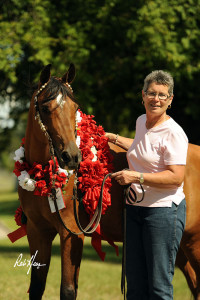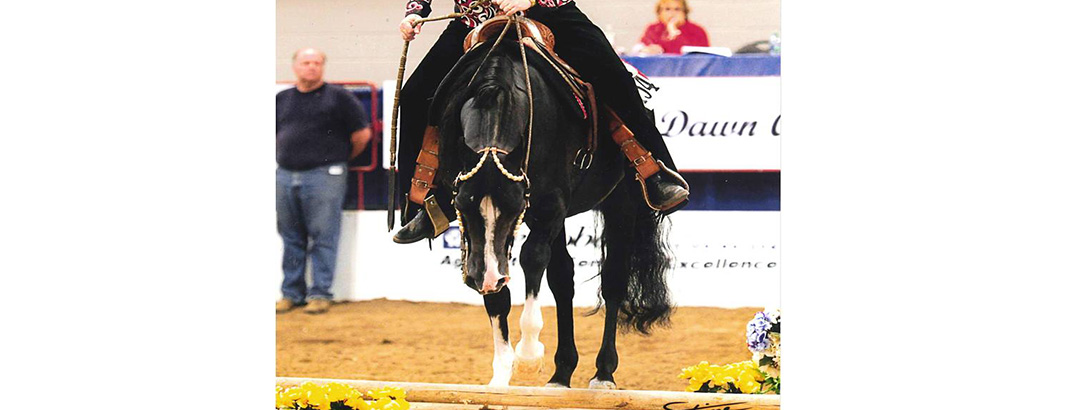by Jackie Davenport
Whatever the trail course or its obstacles, it can be a blast to watch the “go” of a well schooled horse that is confident, curious and athletic. Arena trail is not only fun to watch, more importantly some amount of trail training benefits all horses and riders – western or English – and regardless of whether you show or not. Arena trail includes negotiating obstacles such as poles or logs and bridges, handling gates of all sizes and occasionally even negotiating water hazards and dragging things. Often courses are decorated with flowers and bushes or other items to pique a horse’s curiosity.

Most horses like the change in routine that trail schooling offers. It can help others gain confidence in the arena and working over poles can improve nearly every horse’s striding. Arena trail also gives riders a chance to vary their work and improve their “feel” and general riding skills. No matter what your goal this type of schooling can help you become a better partner with your horse – all while having fun!
Modern arena trail is all about maneuverability, willingness and, most importantly, agility. The trail horse must negotiate obstacles with style and ideally never touch a thing. Horses must perform back-throughs, side passes and must be able to turn and circle in small spaces which can be very challenging. Often the courses are tight and transitions must be exact. So….sounds like fun? Where and how do you start?
Schooling for trail takes time and patience so it’s best to start out with simple maneuvers and build over time, much like teaching someone to read. You start out with just the ABC’s, then progress to a word. No matter what your horse’s actual age, if they’ve not negotiated trail obstacles before they are a new student. You want them to learn and build confidence in the process.
I like to begin with one or two jog/trot poles or one lope/canter pole. Trail is judged, in part, on striding over and between the poles so, the jog poles for western horses should be set 3-3.5 feet apart. For an English horse widen that space to 4.5 feet. As a horse develops, the measurements can be more approximate but when I’m schooling a novice horse I take great care so the measurements will be as close to “perfect striding” as possible. I’ve had beginning trail horses that were curious and interested and others that weren’t so sure about the obstacles. Start with simple exercises to give the horse the confidence it needs to build up to future, more complicated obstacles. A simple start also gives horse and rider a practical exercise in collection, striding and balance.
During this starting phase those two jog/trot poles make a good starting back-through obstacle (though sometimes I have to widen the poles to build confidence). I find it’s best to start teaching the back-through by walking the horse forward through the parallel jog/trot poles, asking them to halt, then slowly asking for a straight back-up. I’ll save teaching the horse to back into the actual obstacle for later, when they’re more confident.
A great thing about starting out with trail is that you can always reduce things to their simplest common denominator. To begin with, a horse must always be able to do maneuvers without poles. For example, until a horse can lope or canter correctly, I’ll not lope or canter it over poles; the same thing can be said of the jog/trot and even the walk. Until a horse can back up nicely, in a straight line, without rushing, I’ll not try to teach them to back through an obstacle. You get the idea. And, if a horse is afraid of the poles, I just encourage him or I’ll have him follow a veteran horse over or through an obstacle. Before you know it, he’s doing it on his own. I never punish an inexperienced horse over poles; I believe in letting the poles teach the horse. And, most of all, I believe in having fun while you learn. I hope this article has encouraged you to learn more about arena trail. Join me next month for more on this fun discipline.

Jackie Davenport has been putting the foundation and finish on champions for over 30 years. She has trained multiple national champions and currently specializes in riders with goals that include wins at the national and regional levels of the Arabian circuit. Jackie has also produced many winning horse and rider teams in the Quarter Horse, Paint, Appaloosa, Pinto and Morgan arenas and has judged at a variety of venues. Jackie’s consistent, foundation-oriented training methods produce results. Her methods are based on fair treatment and education for both the horse and the rider. Visit jackiedavenport.com or follow her on Facebook.
Published in September 2015 Issue
Jackie Davenport has been putting the foundation and finish on champions for over 30 years. She has trained multiple national champions and currently specializes in riders with goals that include wins at the national and regional levels of the Arabian circuit. Jackie has also produced many winning horse and rider teams in the Quarter Horse, Paint, Appaloosa, Pinto and Morgan arenas and has judged at a variety of venues. Jackie’s consistent, foundation-oriented training methods produce results. Her methods are based on fair treatment and education for both the horse and the rider. Visit jackiedavenport.comjackiedavenport.com or follow her on Facebook.






